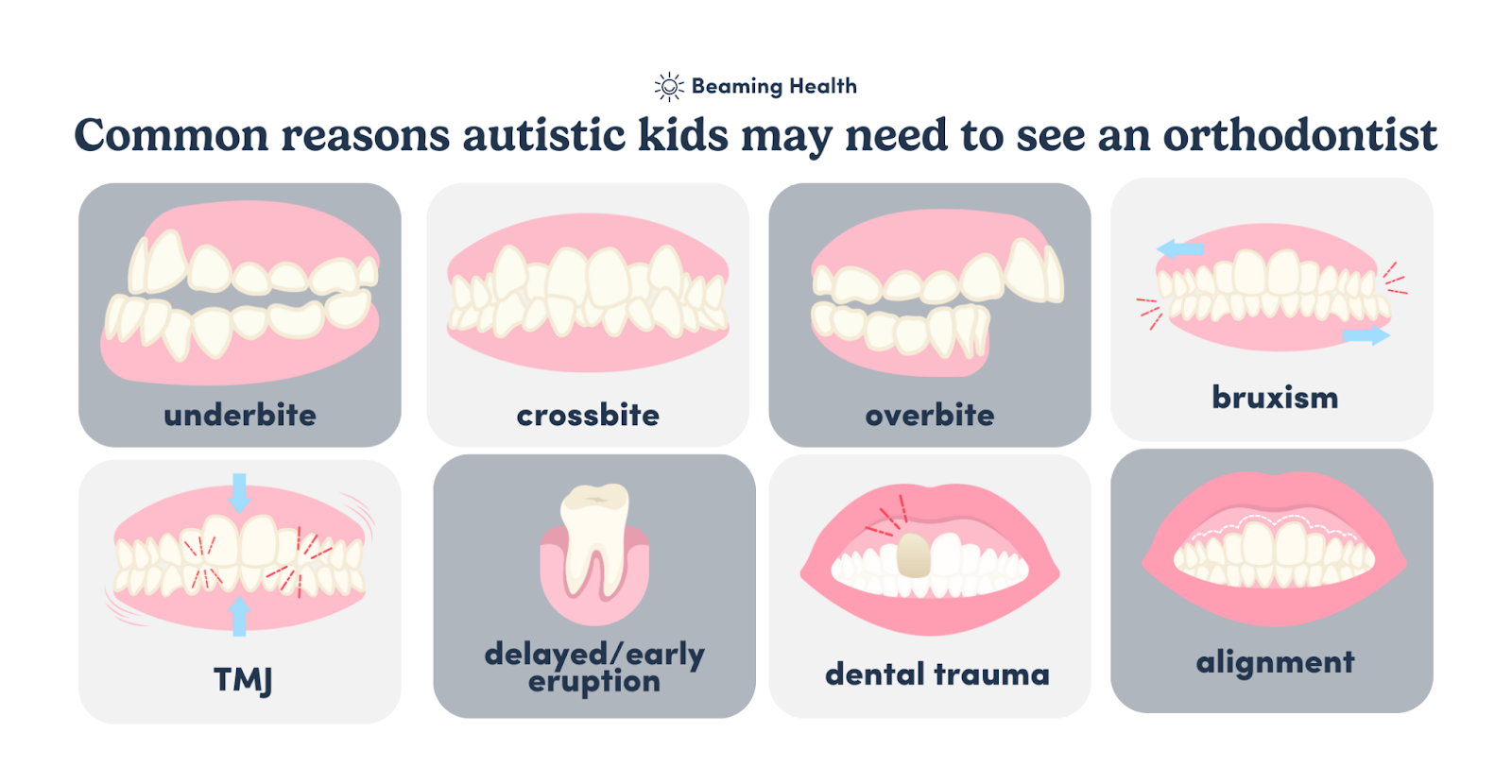Does my child need an orthodontist? What parents of autistic kids need to know
Updated: August 31, 2023 · 6 Minute Read

Reviewed by:
Amy Gong, Neurodiversity Advocate
Highlights
- Orthodontists are specialty dentists who focus on the jaws and teeth. They help with things like teeth grinding, overbites, and dental injuries, which can cause pain, cavities, and difficulties speaking.
- Your child should see an orthodontist before age 7 to find and address issues before they get worse. Some issues can be fixed in early childhood before the jaw stops growing.
- Autistic children may be prone to things like dental trauma, early tooth eruption, and teeth grinding.
- You can work to prevent orthodontic problems by practicing good oral hygiene at home and building a good relationship with your child’s dentist.
Concerned about your child’s teeth? While the field of orthodontics has a long way to go in providing compassionate care for people with developmental differences, your child has the right to quality dental care — the same as anyone else. So what is an orthodontist, and when does your child need one? “Brace” yourself, we’re getting into all things orthodontia!
What’s an orthodontist?
Orthodontists are specialists in the field of dentistry who focus on bite, jaw, and alignment issues. Their main focus is to make sure your child’s smile is aligned, their bite is functional, and their jaw is balanced. Orthodontists treat all kinds of alignment issues like crowding, overbites, underbites, gaps in teeth, crooked teeth, and jaw concerns. One of the most common ways orthodontists treat these issues is through braces. Orthodontists complete additional training after dental school to specialize in orthodontia.
When should my child see an orthodontist?
The general recommendation is that kids should see an orthodontist by age 7. This is so the orthodontist can identify and address issues before they become more serious. The orthodontist will evaluate your child’s jaw, alignment, bite, baby and permanent teeth, plus skeletal development to make sure it’s all progressing the way it should. This is important because some jaw issues can be corrected in early childhood, before the jaw stops growing. Keep in mind that orthodontists do more than just install braces. Most orthodontic issues are inherited; orthodontists can find problems before your child’s permanent teeth have all come in. Your child doesn’t have to have a referral from the dentist to see an orthodontist. Usually parents are the ones to spot the signs, anyway.

Common reasons autistic children may need an orthodontist
It’s important to know that there are no physiological differences in the teeth of autistic kids. This means that your child’s teeth aren’t different from any other child’s teeth just because they’re autistic. Autistic kids experience the same dental issues as any other kid, but may be more prone to certain ones than their non-autistic peers. Reasons for this may include mouth sensitivity, poor oral hygiene, and difficulty accessing quality dental care.
Here are some common reasons an autistic child may need to see an orthodontist:
- Malocclusion (crowding and bite alignment issues). Overbites, underbites, “open” overbites, crooked teeth, crowded teeth, and gapped teeth are all examples of malocclusion. Autistic kids are more prone to malocclusion than their non-autistic peers. We’re not exactly sure why this happens. Autistic kids tend to have more sensitive mouths than neurotypical kids. This makes it hard to get the preventive care they need to stop malocclusions from happening. Malocclusions can make it hard to get teeth clean, leading to more cavities. Malocclusions can contribute to speech difficulties and cause problems in the way your child’s mouth functions.
- Delayed or early expulsion (permanent teeth coming in late or early). Neurodivergent kids sometimes have permanent teeth that come in too early or baby teeth that fall out too late, which can cause a lot of pain. Early expulsion can lead to crowded teeth (teeth overlapping with each other). It’s not exactly clear why neurodivergent kids struggle with this, or if they have more expulsion problems than non-autistic kids. The field of orthodontics doesn’t have much research about treating autistic patients.
- Parafunctions (thumb sucking, oral stimming, etc.). Parafunctions are when you use your mouth for things other than eating, drinking, or speaking. Autistic kids often have oral sensory-seeking behavior like thumb sucking or chewing on non-food items. Other common parafunctions include grinding teeth, biting nails, sucking cheeks or teeth, and biting lips or cheeks. Another parafunction, tongue thrusting, is when the tongue pushes up against the teeth when swallowing. These parafunctions can cause malocclusions and other dental concerns.
- Bruxism (teeth grinding, gnashing, or clenching). This is a type of parafunction that can cause a lot of pain and symptoms like headaches, earaches, and tooth sensitivity. There are two kinds of bruxism; waking and sleeping. Autistic kids may be more prone to bruxism, as it’s often caused by anxiety. Bruxism can lead to several problems including TMJ Disorder (Temporomandibular Joint Disorder).
- TMJ (Temporomandibular Joint Disorder). TMJ is a condition of misalignment of the jaw joint. When the jaw joint isn’t aligned it causes pain and jaw dysfunction. This joint can put pressure on other structures in the mouth. TMJ can be caused by jaw injury (like dislocation), teeth grinding (bruxism), stress/muscle tension, or arthritis. Some signs to watch out for are: clicking or popping sounds when opening or closing the mouth, face pain, headaches or jaw aches, difficulty chewing/swallowing, or struggle with limited jaw movement. If you notice any of these signs in your child, please consult with a professional to work out a treatment plan.
- Jaw growth or alignment issues. Sometimes a child’s jaw may not grow evenly or may be misaligned. An example would be if the lower jaw grows larger than the top. If the jaw is misaligned or doesn’t grow evenly, it can cause bite and alignment problems. Jaw growth and alignment can also play a role in speech difficulties and joint troubles.
- Dental trauma (broken or displaced teeth). Autistic kids may be more prone to dental trauma. Examples of dental trauma are: broken teeth, a tooth being pushed further up into the gums, injuries to the gums, tongue, or other soft tissue, and more. If your child plays sports, hits themselves (self-injury), or falls down often, they’re at higher risk for dental trauma. Addressing dental trauma as quickly as possible will increase the chances of preserving/fixing the tooth and reduce your child’s pain. If your child experiences dental trauma, contact a professional ASAP.
For more reasons your child may need to see an orthodontist (including what to look out for), check out the American Association of Orthodontists FAQ.
How does an orthodontist fix these issues?
The most common type of fix orthodontists use is braces. (Check out our full guide to braces for autistic kids!) Orthodontists may also use retainers or “headgear” to help with jaw and teeth alignment issues. If the issue is serious enough, an orthodontist may perform surgery to reshape or align the jaw. It’s called orthognathic surgery, and is usually performed with consultation from an oral surgeon. Orthodontists typically don’t perform surgery on children until their jaw stops growing (around age 16). Your child’s orthodontist will take X-rays and models of their teeth, then figure out the best treatment plan for them. You can expect for orthodontic treatment to take several visits over time to complete.
Conclusion
Autistic kiddos may need an orthodontist for a variety of dental problems. These problems can cause pain, cavities, speech difficulties, and other challenges. Play it safe and get your child’s smile checked by an orthodontist before they turn 7. Nip orthodontic issues in the bud by establishing good oral hygiene habits at home and building a good relationship with your child’s dentist. Want to know more about keeping your child’s smile healthy? Check out our guide to prepping your child for a dentist appointment.
Get our best articles delivered to your inbox each month.
We respect your privacy.
Article References
- Fontaine-Sylvestre, C., Roy, A., et al. Prevalence of malocclusion in Canadian children with autism spectrum disorder. American Journal of Orthodontics and Dentofacial Orthopedics. 2017;152(1):38-41. https://www.sciencedirect.com/science/article/abs/pii/S0889540617302615
- Meuffels, S.A., Kuijpers-Jagtman, A.M., Tjoa, S.T.H. et al. Malocclusion complexity and orthodontic treatment need in children with autism spectrum disorder. Clin Oral Invest 26, 6265–6273 (2022). https://doi.org/10.1007/s00784-022-04578-8
- Elston, C. Straight teeth for kids with special needs. L.A. Parent. Published July 29, 2014. https://www.laparent.com/straight-teeth-for-kids-with-special-needs/
- Common Orthodontic Problems. American Association of Orthodontists. https://aaoinfo.org/resources/common-orthodontic-problems/
- Child Orthodontics. American Association of Orthodontists. https://aaoinfo.org/faqs/child-orthodontics/page/4/













